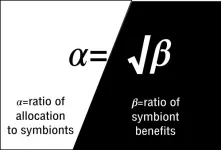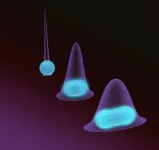(Press-News.org) Increased acidity in the atmosphere is disrupting the ecological balance of the oceans, according to new research led by the University of East Anglia (UEA).
The first study to look at acidity's impact on nutrient transport to the ocean demonstrates that the way nutrients are delivered affects the productivity of the ocean and its ability to absorb CO2 from the atmosphere.
The research, 'Changing atmospheric acidity as a modulator of nutrient deposition and ocean biogeochemistry', is published today in Science Advances. The analysis was carried out by an international team of experts, sponsored by the United Nations Group of Experts on the Scientific Aspects of Marine Environmental Protection (GESAMP).
Prof Alex Baker, professor of marine and atmospheric chemistry in UEA's School of Environmental Sciences, is the lead author. He said: "Human emissions of pollutants have caused significant changes to the acidity of the atmosphere, leading to well-known environmental impacts such as acid rain.
"Atmospheric acidity affects the quantity and distribution of nutrients (nitrogen, phosphorus and iron) delivered to the ocean.
"Acids attack the surface of desert dust particles as they are transported through the atmosphere, increasing the proportion of the phosphorus and iron contained in those particles that will dissolve when the dust falls into the ocean.
"Our work suggests that increasing acidity since the Industrial Revolution increased the proportions of phosphorus and iron that are soluble by 14 per cent and 16 per cent respectively. These increases will have had a direct fertilizing effect on marine phytoplankton."
Over the same time period, pollutant emissions have at least doubled the amount of nitrogen added to the oceans via the atmosphere.
Prof Maria Kanakidou of the University of Crete in Heraklion, Greece, also contributed to the research using global chemistry transport deposition modelling. She said: "Acidity controls the distribution of nitrogen between particles and gases in the atmosphere, so that changes in acidity alter the length of time that nitrogen remains in the atmosphere and hence where in the ocean it will be deposited."
In addition to fertilization, these changes in the amount and geographic distribution of nutrient deposition also affect the ecological balance of the ocean.
Prof Kanakidou said: "Phytoplankton communities are sensitive to the proportions of nutrients available to them. The changes in nutrient deposition that we have identified will likely have led to ecological shifts as the atmospheric input alters the nutrient balance of surface waters. These changes can promote certain phytoplankton types over others, depending on the organisms' adaptation to the relative levels of nutrients present in the water."
Another team member, Prof Athanasios Nenes, is from the Ecole Polytechnique Fédérale de Lausanne, Switzerland, and the Center for the Study of Air Quality and Climate Change of the Foundation for Research and Technology Hellas in Patras, Greece.
Prof Nenes said: "Fine aerosol particles tend to remain strongly acidic, despite considerable reductions in pollutants. Understanding this counter-intuitive behavior and its impact on nutrient supply to the ocean has only become possible thanks to advances in theory and modelling.
"Anthropogenic emissions will continue to change the acidity of the atmosphere into the future. Emissions controls implemented to address acid rain will reduce aerosol acidity in many regions of the world, while continued economic development is likely to see further increases in acidity in other regions."
The system is unlikely to return to its pre-Industrial condition, because wildfires - which influence both nutrient supply and acidity - will play a more important role in a warmer climate and the impact of this is highly uncertain.
Prof Baker said: "Knowledge of the complex interactions between nutrient supply and marine microbial communities is limited. Predictions of the consequences of long-term changes in atmospheric acidity on marine ecosystems will need to be considered alongside other stressors on the system, such as ocean acidification, warming and deoxygenation."
INFORMATION:
'Changing atmospheric acidity as a modulator of nutrient deposition and ocean biogeochemistry', is published 7 July 2021 in Science Advances.
To create high-resolution, 3D images of tissues such as the brain, researchers often use two-photon microscopy, which involves aiming a high-intensity laser at the specimen to induce fluorescence excitation. However, scanning deep within the brain can be difficult because light scatters off of tissues as it goes deeper, making images blurry.
Two-photon imaging is also time-consuming, as it usually requires scanning individual pixels one at a time. A team of MIT and Harvard University researchers has now developed a modified version of two-photon imaging that can image deeper within tissue and perform the imaging much more quickly than what was previously possible.
This kind of imaging could allow scientists to more rapidly obtain ...
Metastatic tumors originating from notoriously aggressive triple-negative breast cancer that emerge in the lungs contain a more diverse array of cancer cells than those that arise in the liver, according to a new study in mice and organs from deceased cancer patients. The study also identified a set of genes that distinguish lung and liver metastases; together, the findings may inform future research on how targeted therapies impact tumors across various microenvironments. While scientists have known that the presence of distinct tumor cell populations within the same tumor drives breast cancer progression, it has not been fully understood why this dangerous cellular diversity develops within some tumors and not others. To investigate ...
From above, the Antarctic Ice Sheet might look like a calm, perpetual ice blanket that has covered Antarctica for millions of years. But the ice sheet can be thousands of meters deep at its thickest, and it hides hundreds of meltwater lakes where its base meets the continent's bedrock. Deep below the surface, some of these lakes fill and drain continuously through a system of waterways that eventually drain into the ocean.
Now, with the most advanced Earth-observing laser instrument NASA has ever flown in space, scientists have improved their maps of these hidden lake systems under the West Antarctic ice sheet--and ...
"Equal pay for equal work," a motto touted by many people, turns out to be relevant to the plant world as well. According to new research by Stanford University ecologists, plants allocate resources to their microbial partners in proportion to how much they benefit from that partnership.
"The vast majority of plants rely on microbes to provide them with the nutrients they need to grow and reproduce," explained Brian Steidinger, a former postdoctoral researcher in the lab of Stanford ecologist, Kabir Peay. "The problem is that these microbes differ in how well they do the job. We wanted to see how the plants reward their microbial employees."
In a new study, published July 6 in the journal American Naturalist, the researchers investigated ...
Very recently, researchers led by Markus Aspelmeyer at the University of Vienna and Lukas Novotny at ETH Zurich cooled a glass nanoparticle into the quantum regime for the first time. To do this, the particle is deprived of its kinetic energy with the help of lasers. What remains are movements, so-called quantum fluctuations, which no longer follow the laws of classical physics but those of quantum physics. The glass sphere with which this has been achieved is significantly smaller than a grain of sand, but still consists of several hundred million atoms. In contrast to ...
DURHAM, N.C. -- You dash into a convenience store for a quick snack, spot an apple and reach for a candy bar instead. Poor self-control may not be the only factor behind your choice, new research suggests. That's because our brains process taste information first, before factoring in health information, according to new research from Duke University.
"We spend billions of dollars every year on diet products, yet most people fail when they attempt to diet," said study co-author Scott Huettel, a professor of psychology and neuroscience at Duke. "Taste seems to have an advantage that sets us up for failure."
"For many individuals, health information enters the decision process ...
Injecting sulphur into the stratosphere to reduce solar radiation and stop the Greenland ice cap from melting. An interesting scenario, but not without risks. Climatologists from the University of Liège have looked into the matter and have tested one of the scenarios put forward using the MAR climate model developed at the University of Liège. The results are mixed and have been published in the journal The Cryosphere.
The Greenland ice sheet will lose mass at an accelerated rate throughout the 21st century, with a direct link between anthropogenic greenhouse gas emissions and the extent of Greenland's mass loss. To combat this phenomenon, and therefore global warming, it is essential to reduce ...
ITHACA, N.Y. - An interdisciplinary team of Cornell and Harvard University researchers developed a machine learning tool to parse quantum matter and make crucial distinctions in the data, an approach that will help scientists unravel the most confounding phenomena in the subatomic realm.
The Cornell-led project's paper, "Correlator Convolutional Neural Networks as an Interpretable Architecture for Image-like Quantum Matter Data," published June 23 in Nature Communications. The lead author is doctoral student Cole Miles.
The Cornell team was led by Eun-Ah Kim, professor of physics in the College of Arts and Sciences, who partnered with Kilian Weinberger, associate professor of computing and information science in the Cornell Ann S. ...
When you insist you're not racist, you may unwittingly be sending the opposite message.
That's the conclusion of a new study* by three Berkeley Haas researchers who conducted experiments with white participants claiming to hold egalitarian views. After asking them to write statements explaining why they weren't prejudiced against Black people, they found that other white people could nevertheless gauge the writers' underlying prejudice.
"Americans almost universally espouse egalitarianism and wish to see themselves as non-biased, yet racial prejudice persists," says Berkeley ...
A genetic map of an aggressive childhood brain tumour called medulloblastoma has helped researchers identify a new generation anti-cancer drug that can be repurposed as an effective treatment for the disease.
This international collaboration, led by researchers from The University of Queensland's (UQ) Diamantina Institute and WEHI in Melbourne, could give parents hope in the fight against the most common and fatal brain cancer in children.
UQ lead researcher Dr Laura Genovesi said the team had mapped the genetics of these aggressive brain tumours for five years to find new pathways that existing drugs could potentially target.
"These are drugs already approved for other diseases or cancers but have never been tested in paediatric brain tumours," Dr Genovesi ...



